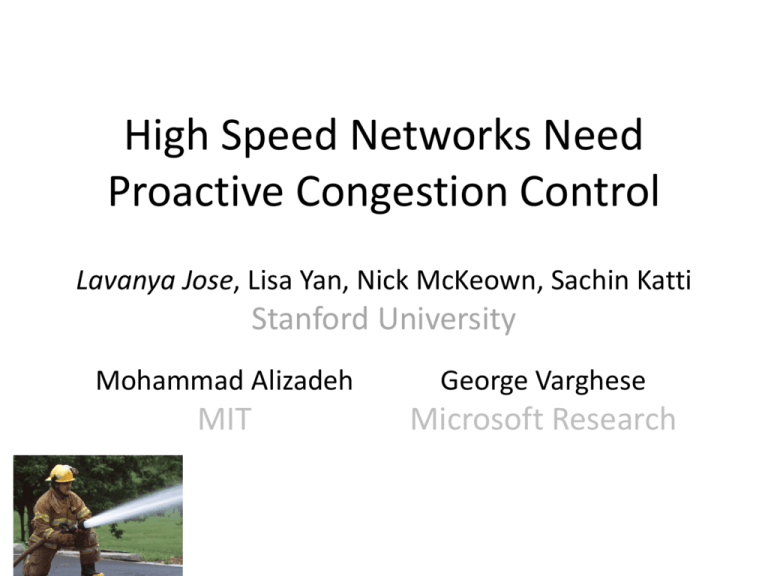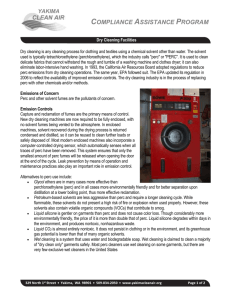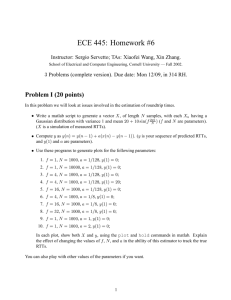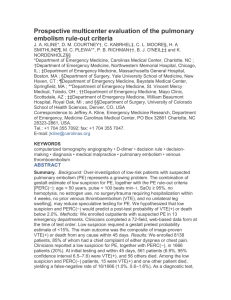slides in - Stanford University
advertisement

High Speed Networks Need Proactive Congestion Control Lavanya Jose, Lisa Yan, Nick McKeown, Sachin Katti Stanford University Mohammad Alizadeh George Varghese MIT Microsoft Research The Congestion Control Problem Link 1 60 G Link 0 100 G Link 2 30 G Flow A Link 3 10 G Link 4 100 G Flow C Flow B Flow D Ask an oracle. Link 0 Link Link 1 0√ Flow A √ 1√ Flow B Flow C 2 Flow D 3 4 Link 0 100 G Link 1 60 G Capacity Link 2 LinkFlow 3 Link 4Rate 100 Flow A 35 √60 Flow B 25 √30 √ Flow C 5 10 √ Flow D √ 5 100 Link 2 30 G Flow A = 35G Link 3 10 G Link 4 100 G Flow C = 5G Flow B = 25G Flow D = 5G Traditional Congestion Control • No explicit information about traffic matrix • Measure congestion signals, then react by adjusting rate after measurement delay • Gradual, can’t jump to right rates, know direction • “Reactive Algorithms” 60 0 1 Transmission Rate (Gbps) 10 20 30 40 50 01 Link 0 100 G 3 5 Link 1 60 G 10 20 30 Time (# of RTTs, 1 RTT=24us) Link 2 30 G Flow A = 35G 40 Link 3 10 G Link 4 100 G Flow C = 5G Flow B = 25G Flow D = 5G 60 1 Transmission Rate (Gbps) 10 20 30 40 50 0 Ideal (dotted) 01 Link 0 100 G 3 5 Link 1 60 G 10 20 30 Time (# of RTTs, 1 RTT=24us) Link 2 30 G Flow A = 35G 40 Link 3 10 G Link 4 100 G Flow C = 5G Flow B = 25G Flow D = 5G 60 1 Transmission Rate (Gbps) 10 20 30 40 50 RCP (dashed) 0 Ideal (dotted) 01 Link 0 100 G 3 5 Link 1 60 G 10 20 30 Time (# of RTTs, 1 RTT=24us) Link 2 30 G Flow A = 35G 40 Link 3 10 G Link 4 100 G Flow C = 5G Flow B = 25G Flow D = 5G 60 1 Transmission Rate (Gbps) 10 20 30 40 50 RCP (dashed) 0 Ideal (dotted) 01 Link 0 100 G 3 5 Link 1 60 G 10 20 30 Time (# of RTTs, 1 RTT=24us) Link 2 30 G Flow A = 35G 40 Link 3 10 G Link 4 100 G Flow C = 5G Flow B = 25G Flow D = 5G 60 1 Transmission Rate (Gbps) 10 20 30 40 50 RCP (dashed) 0 Ideal (dotted) 01 Link 0 100 G 3 5 Link 1 60 G 10 20 30 Time (# of RTTs, 1 RTT=24us) Link 2 30 G Flow A = 35G 40 Link 3 10 G Link 4 100 G Flow C = 5G Flow B = 25G Flow D = 5G 60 1 Transmission Rate (Gbps) 10 20 30 40 50 RCP (dashed) 0 Ideal (dotted) 01 Link 0 100 G 3 5 Link 1 60 G 10 20 30 Time (# of RTTs, 1 RTT=24us) Link 2 30 G Flow A = 35G 40 Link 3 10 G Link 4 100 G Flow C = 5G Flow B = 25G Flow D = 5G 60 1 Transmission Rate (Gbps) 10 20 30 40 50 30 RTTs to Converge RCP (dashed) 0 Ideal (dotted) 01 Link 0 100 G 3 5 Link 1 60 G 10 20 30 Time (# of RTTs, 1 RTT=24us) Link 2 30 G Flow A = 35G 40 Link 3 10 G Link 4 100 G Flow C = 5G Flow B = 25G Flow D = 5G Convergence Times Are Long • If flows only last a few RTTs, then we can’t wait 30 RTTs to converge. • At 100G, a typical flow in a search workload is < 7 RTTs long. Fraction of Total Flows in Bing Workload 14% Small (1-10KB) Medium (10KB-1MB) Large (1MB-100MB) 30% 56% 1MB / 100 Gb/s = 80 µs Why “Reactive” Schemes Take Long 1. 2. 3. 4. 5. No explicit information Therefore measure congestion signals, react Can’t leap to correct values but know direction Reaction is fed back into network Take cautious steps Adjust Flow Rate Measure Congestion Transmissi 10 20 0 01 3 5 10 20 30 Time (# of RTTs, 1 RTT=24us) Reactive algorithms trade off explicit flow information for long convergence times Can we use explicit flow information and get shorter convergence times? 40 Back to the oracle, how did she use traffic matrix to compute rates? Link 0 100 G Link 1 60 G Link 2 30 G Flow A = 35G Link 3 10 G Link 4 100 G Flow C = 5G Flow B = 25G Flow D = 5G Waterfilling Algorithm Link 0 (0/ 100 G) Link 4 (0/ 100 G) Link 1 (0/ 60 G) Flow A (0 G) Flow B (0 G) Link 2 (0/ 30 G) Link 3 (0/ 10 G) Flow C (0 G) Flow D (0 G) Waterfilling- 10 G link is fully used Link 0 (5/ 100 G) Link 1 (10/ 60 G) Flow A (5 G) Flow B (5 G) Link 4 (5/ 100 G) Link 2 (10/ 30 G) Link 3 (10/ 10 G) Flow C (5 G) Flow D (5 G) Waterfilling- 30 G link is fully used Link 0 (25/ 100 G) Link 1 (50/ 60 G) Flow A (25 G) Flow B (25 G) Link 4 (5/ 100 G) Link 2 (30/ 30 G) Link 3 (10/ 10 G) Flow C (5 G) Flow D (5 G) Waterfilling- 60 G link is fully used Link 0 (35/ 100 G) Link 1 (60/ 60 G) Flow A (35 G) Flow B (25 G) Link 4 (5/ 100 G) Link 2 (30/ 30 G) Link 3 (10/ 10 G) Flow C (5 G) Flow D (5 G) Fair Share of Bottlenecked Links Link 0 (35/ 100 G) Flow A (35 G) Flow B (25 G) Fair Share: 35 G Link 4 (5/ 100 G) Link 1 (60 G) Fair Share: 25 G Fair Share: 5 G Link 2 (30 G) Link 3 (10 G) Flow C (5 G) Flow D (5 G) A centralized water-filling scheme may not scale. Can we let the network figure out rates in a distributed fashion? Fair Share for a Single Link flow demand A B ∞ ∞ Capacity at Link 1: 30G So Fair Share Rate: 30G/2 = 15G 15 G Link 1 30 G Flow A ∞ Flow B ∞ A second link introduces a dependency flow demand A B ∞ 10 ∞G Link 1 30 G Link 2 10 G Flow A Flow B Dependency Graph Flow A Link 1 30 G Flow B Link 2 10 G Dependency Graph Flow A Flow B Link 1 30 G 10 10 Link 2 10 G Proactive Explicit Rate Control (PERC) Overview Round 1 (Flows Links) • Flows and links alternately exchange messages. • A flow sends a “demand” Flow A – ∞ when no other fair share – min. fair share of other links Flow B • A link sends a “fair share” – C/N when demands are ∞ – otherwise use water-filling ∞ ∞ ∞ 1 1 5 5 Link 1 30 G 1 0 Link 2 10 G Proactive Explicit Rate Control (PERC) Overview Round 2 (Flows Links) • Flows and links alternately exchange messages. • A flow sends a “demand” – ∞ when no other fair share – min. fair share of other links • A link sends a “fair share” – C/N when demands are ∞ – otherwise use water-filling • Messages are approximate, jump to right values quickly with more rounds Flow A Flow B ∞ 1 1 0 5 Link 1 30 G Link 2 10 G Proactive Explicit Rate Control (PERC) Overview Round 2 (Links Flows) • Flows and links alternately exchange messages. • A flow sends a “demand” – ∞ when no other fair share – min. fair share of other links • A link sends a “fair share” – C/N when demands are ∞ – otherwise use water-filling • Messages are approximate, jump to right values quickly with more rounds Flow A Flow B 2 2 0 0 Link 1 30 G 1 0 Link 2 10 G Message Passing Algorithms Decoding error correcting codes (LDPC- Gallager, 1963) Parity Check 1 x1 0 x2 1 x3 x1 + x3 = 0 Parity Check 2 1 x2+ x3 = 0 ... ... Flow counts using shared counters (Counter Braids- Lu et al, 2008) Flow A Counter 1 36 Flow B Counter 2 32 Making PERC concrete PERC Implementation Control Packet For Flow B d| ∞ | ∞ f| ? | ? Link 1 30 G Link 2 10 G Flow A Flow B PERC Implementation Control Packet For Flow B d| ∞ | ∞ f|15 f| ? | ? Link 1 30 G Link 2 10 G Flow A Flow B PERC Implementation Control Packet For Flow B d| ∞ | ∞ f|15 |10 | ? Link 1 30 G Link 2 10 G Flow A Flow B PERC Implementation Control Packet For Flow B d| ∞ | ∞ d|10 |15 f|15 f|? |10 | ? Link 1 30 G Link 2 10 G Flow A send at 15G! Flow B <5 RTTs RCP took 30 RTTs to Converge PERC (solid) Ideal (dotted) 0 1 Transmission Rate (Gbps) 10 20 30 40 50 60 PERC converges fast 01 Link 0 100 G 3 5 Link 1 60 G 10 20 30 Time (# of RTTs, 1 RTT=24us) Link 2 30 G Flow A = 35G Link 3 10 G 40 Link 4 100 G Flow C = 5G Flow B = 25G Flow D = 5G 0.60 4 vs 14 at Median 10 vs 71 at Tail (99th) 0.40 1%TOR% Edge%Links 0.20 PERC RCP 4%Hosts% 0.00 CDF 0.80 0.99 PERC Converges Fast 0 10 20 40 60 RTTs to converge 80 100 Some unanswered questions • How to calculate fair shares in PERC switches? • How to bound convergences times in theory? • What about other policies? Takeways • Reactive schemes are slow for short flows (majority) at 100G • Proactive schemes like PERC are fundamentally different and can converge quickly because they calculate explicit rates based on out of band information about set of active flows. • Message passing promising proactive approachcould be practical, need further analysis to understand good convergence times in practice. Thanks! Shorter FCTs For Flows That Last A Few RTTs (“Medium”) 100G, 12us 0 2 Mean FCT (norm. by IDEAL) 7 4.5 2 0 Tail FCT (norm. by IDEAL) 9 RCP DCTCP PERC Small Flows Medium Flows Large Flows XCP RCP 0.60 0.40 0.20 PERC CHARNY RCP 0.00 CDF 0.80 0.99 ATM/ Charny etc. 0 10 20 40 60 RTTs to converge 80 100 Discussion • Fundamentally any limit on how fast we can get max-min rates? Explicit or implicit whatever






